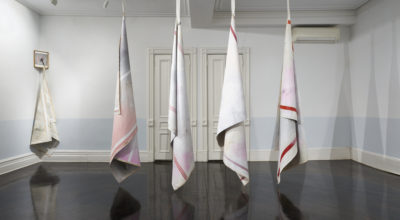English
ÉLISABETH LEBOVICI: WHAT AIDS HAS DONE TO HER
Activist, critic and art historian Élisabeth Lebovici’s plume transits the sinuosity of a paradox without contradiction. Silence and voice, life and death, ethics and aesthetics. Throughout her career, the fight against HIV/AIDS and other causes fought by the LGTBQIA+ community imbue a dense corporeality into her particular way of theory making. At a time of new uncertainty and viral panic, looking back at the AIDS epidemic is a sallow reminder of the indifference that medical and political powers can have for the rights of sexual minorities, but also an invitation to live once more the stridency with which artists and activists fought in order to make their voices heard.
PERMANENT VS. TEMPORARY EXHIBITIONS IN CHILE
It would be a loss if the current amount of temporary shows would be cut in order to make room for permanent exhibitions. There need to be more spaces to accommodate the rich artistic production. Given the low value the Chilean government attributes to culture, this option is probably not feasible in the near future. Private entities could jump in, with their own projects. However, even more important than practicalities is a general sense of appreciation of art from here.
WHAT THE VIRUS WANTS
The virus was caught into this spirit. Now it believes that you and me and them are us. That ‘We’ are one. That you and me and them are made of the same stuff. That ‘We’ breathe and speak and laugh and spit and sneeze and fever and cough alike. That ‘We’ rejoice and revel and cry and suffer and love and hate alike. That tragedy, contingency, dispossession, and comedy happen to all. This virus, which was brought from its happy latency into a state of global circulation, now wants to show that you and me and them are us.
DIARY OF A PANDEMIC. BY MAGNUM PHOTOGRAPHERS
The COVID-19 outbreak has seen most Magnum photographers restricted in their movements. As part of an ongoing photographer-led initiative, Magnum photographers are sharing information, updates, and new work made in these strange and difficult times. Over coming weeks, they’ll be featuring edits of these images, selected by project leader Peter van Agtmael, alongside personal notes and reflections from Magnum photographers on how they are experiencing the unfolding situation.
AMIDST THE PANDEMIC, PABLO HELGUERA SINGS FOR YOU
«If you want to send a free singing telegram to someone you care about, please email us at grandcentral@fullerton.edu. I can sing romantic opera, zarzuela, Hollywood classics, Broadway Tunes, Mexican folk songs, lullabies and Neapolitan songs. As I told the LA Times, I am not Enrico Caruso, but I am free, and I am alive (and happy to be so). If you feel sad or lonely at home or want to cheer someone you love, contact us and we will deliver -promise! (and it is free).» -Pablo Helguera
ELENA DEL RIVERO’S HEALING FEMINISM
The towels, which are larger than human-scale, take their initial design inspiration from the traditional French Torchon aesthetic but soon become testaments to the artist’s hand, kitchen and home as the canvases bear not only acrylic paint but also stains of wine, turmeric, rust and bleach and are subjected to hand-scrubbing in the artist’s tub. As writer and curator Cecilia Fajardo-Hill writes of del Rivero’s process in the exhibition text, “the performative act of metaphorically cleaning, while also creating and integrating chance into the process of painting, both celebrates and exorcises women’s history in the kitchen.”
COLLECTING IN TIMES OF CRISIS
It is probable that artists whose works you already collect temporarily stop working and exhibiting as usual. They might be actively involved in the protest, join cabildos, or fulfill other civic duties. Everyone will have to reorganize their life according to the new, difficult situation, losing jobs and therefore finding less time for art. This is not a break in their practice, but a momentary hiatus or an interesting turning point. Given the economic precarity of many artists and the fragility of the local art scene, collectors can be a corrective to the downturns.
ARCHAEOLOGIES OF THE SELFIE
“Suddenly, unexpectedly, the utmost narcissistic practice of image-making turned out to be the most effective way to reach others, offering testimony, breaching distance, overcoming reclusion and ultimately showing our resilient, living community, as it faces and triumphs over the dread of global illness. No one could have known either that in a matter of weeks the world would confront the pandemic of COVID-19 at a planetary scale, turning the meaning of selfies upside down, from head to toe,”
DANIEL LIND-RAMOS: STORAGE OF MEMORY
Lind-Ramos has always told powerful stories through his works of art. It’s no wonder as oral, culinary, musical and visual storytelling are part of his Afro-descendent history and fundamental to his philosophy of being. As evident in the seven pieces exhibited here, Lind-Ramos’ sculptures have a powerful spirit-like presence portraying strength, potency, and depth. Each piece conveys a very particular story through the careful selection and use of materials.










